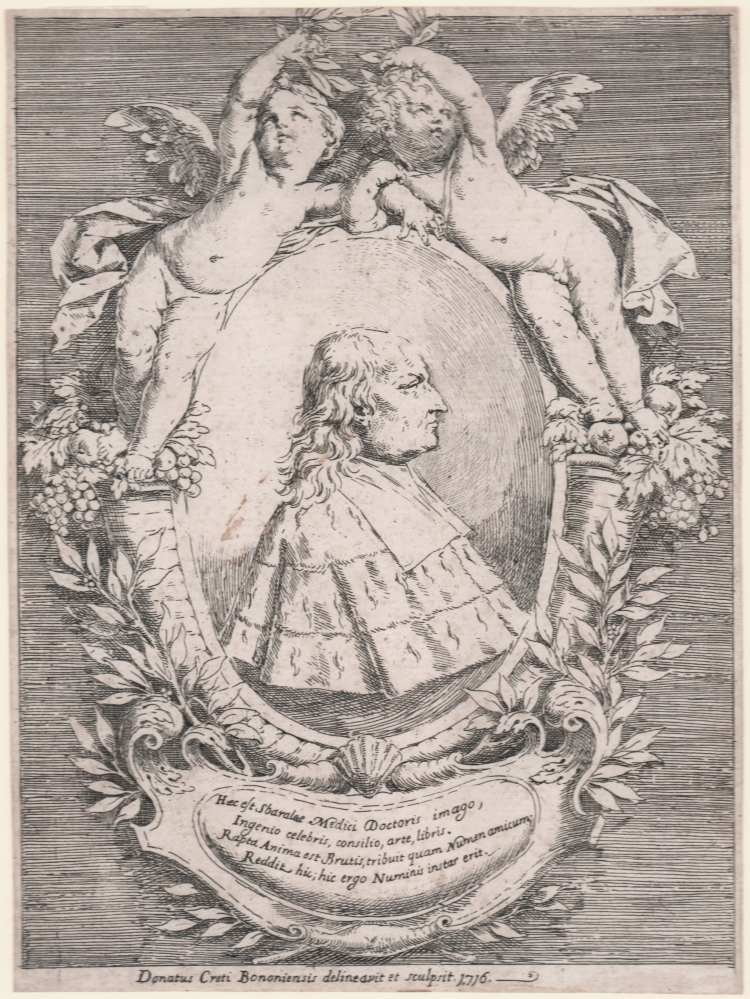



| Reference: | S7240 |
| Author | Donato CRETI |
| Year: | 1716 |
| Measures: | 147 x 197 mm |


| Reference: | S7240 |
| Author | Donato CRETI |
| Year: | 1716 |
| Measures: | 147 x 197 mm |
Portrait of Giovanni Girolamo Sbaraglia, bust, in profile, facing right; within an oval flanked by two putti standing on cornucopias.
Lettered in cartouche with four lines in Latin referring to the sitter and below image with production details: “Donatus Creti Bononiensis delineavit et sculpsit 1716”.
Etching, 1716, signed and dated on plate at bottom on white margin.
Example in the only known state.
Giovanni Girolamo Sbaraglia (physician, intellectual, and academic, 1641 - 1710) was an important Bolognese anatomist whose scientific theories were in sharp contrast to what Marcello Malpighi advocated. Although Sbaraglia never explicitly mentioned him, the main polemical target of his dissertations was Malpighi, who by then had become one of the most famous anatomists of the time. A monument dedicated to Sbaraglia, designed by Donato Creti. is located inside the Archiginnasio Palace of Bologna, next to that of his opponent Malpighi.
Beautiful proof, printed in olive-coloured ink on contemporary laid paper, no watermark, trimmed at the platemark on three sides, slightly indented at the top, in very good conditions.
Donato Creti was an Italian painter and draughtsman. His individual and poetic art represents, with that of Marcantonio Franceschini, the last significant expression of the classical–idealist strain in Bolognese painting. His activity was almost wholly confined to Bologna, where he painted decorative frescoes, altarpieces and easel pictures for private collectors. Two qualities are paramount: a perfected finesse of handling and poetic suggestiveness of situation and mood. He sought the ideal beauty of the individual figure and was thus at his best in meditative pictures with few figures; his subjects combine grace of form and precision of contour with flesh that attains the surface delicacy of porcelain and colours that have a mineral-like refulgence. He was a prolific draughtsman with a distinct personal manner, who drew for pleasure as well as to prepare his compositions, usually using a quill-pen and producing shadowing by hatching.
One of the rare prints by the Cremonese artist.
|
De Vesme 3, Bertelà 263.
|
Donato CRETI (Cremona 1671 – Bologna 1749)
|
Italian painter and draughtsman. His individual and poetic art represents, with that of Marcantonio Franceschini, the last significant expression of the classical–idealist strain in Bolognese painting. His activity was almost wholly confined to Bologna, where he painted decorative frescoes, altarpieces and easel pictures for private collectors. Two qualities are paramount: a perfected finesse of handling and poetic suggestiveness of situation and mood. He sought the ideal beauty of the individual figure and was thus at his best in meditative pictures with few figures; his subjects combine grace of form and precision of contour with flesh that attains the surface delicacy of porcelain and colours that have a mineral-like refulgence. He was a prolific draughtsman with a distinct personal manner, who drew for pleasure as well as to prepare his compositions, usually using a quill-pen and producing shadowing by hatching.
|
|
De Vesme 3, Bertelà 263.
|
Donato CRETI (Cremona 1671 – Bologna 1749)
|
Italian painter and draughtsman. His individual and poetic art represents, with that of Marcantonio Franceschini, the last significant expression of the classical–idealist strain in Bolognese painting. His activity was almost wholly confined to Bologna, where he painted decorative frescoes, altarpieces and easel pictures for private collectors. Two qualities are paramount: a perfected finesse of handling and poetic suggestiveness of situation and mood. He sought the ideal beauty of the individual figure and was thus at his best in meditative pictures with few figures; his subjects combine grace of form and precision of contour with flesh that attains the surface delicacy of porcelain and colours that have a mineral-like refulgence. He was a prolific draughtsman with a distinct personal manner, who drew for pleasure as well as to prepare his compositions, usually using a quill-pen and producing shadowing by hatching.
|